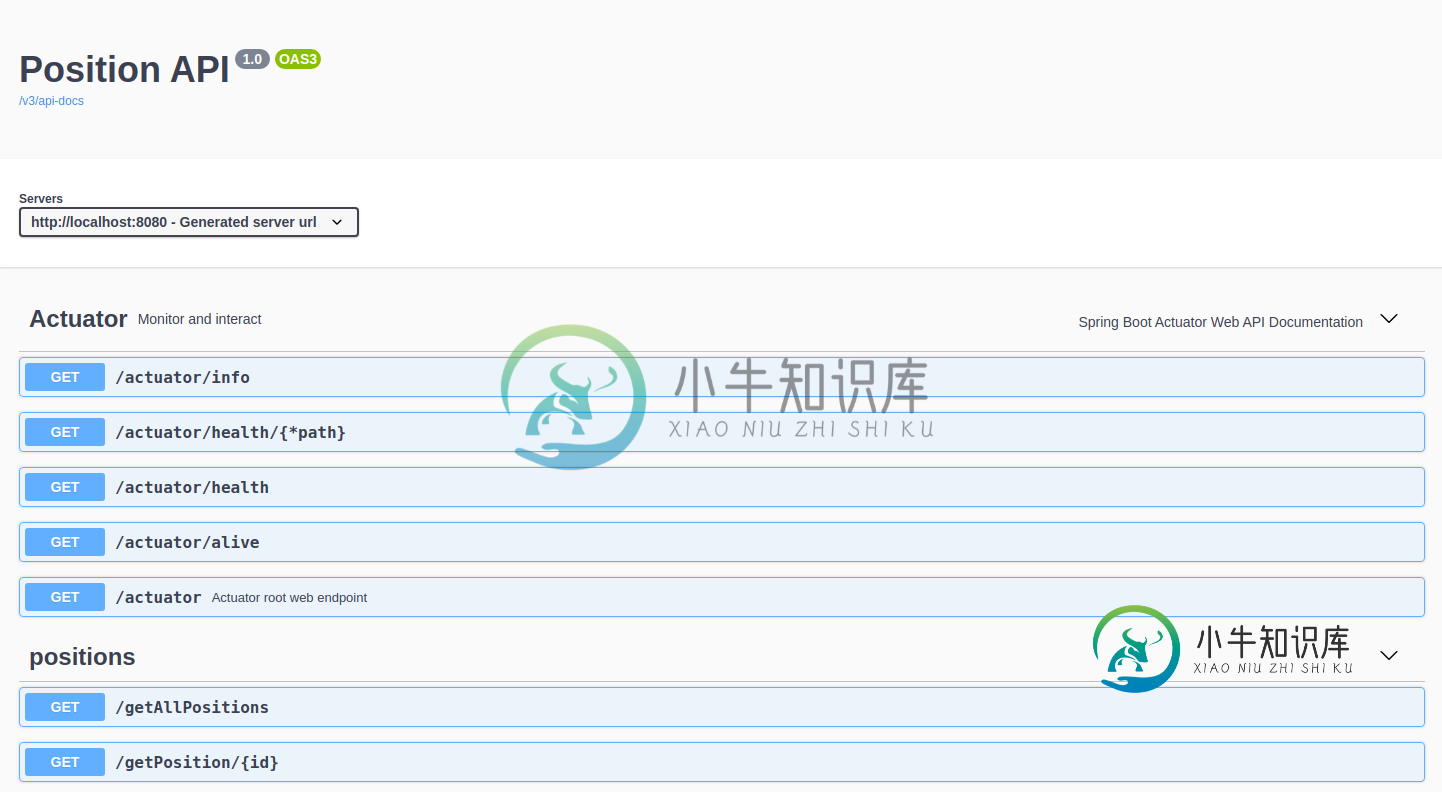Webflux中的SwaggerUI-使用Swagger中的不同端口配置执行器endpoint


所以我的问题是:
-
< li >我如何告诉swagger不要划分api
以下是endpoint的路由器功能以及我如何在此处配置swagger:
@Bean
public RouterFunction<ServerResponse> positionRoute() {
return route().GET("/getAllPositions", accept(MediaType.APPLICATION_JSON), this::getAllPositions, ops -> ops
.operationId("findAll").description("Get all positions").tags(new String[]{"positions"})
.response(responseBuilder().responseCode("200").implementationArray(Position.class))).build()
.and(route().GET("/getPosition/{id}", accept(MediaType.APPLICATION_JSON), this::getPositiionById, ops -> ops
.operationId("findById").description("Find all").tags(new String[]{"positions"})
.parameter(parameterBuilder().in(ParameterIn.PATH).name("id"))
.response(responseBuilder().responseCode("200").implementation(Position.class))).build());
}
共有1个答案
如果管理端口不同于应用端口,且未定义< code > spring doc . use-management-port ,但< code > spring doc . show-actuator 设置为true:
- 然后将通过应用程序端口访问swagger-用户界面。例如:
\超文本传输协议://serverName: Application ationPort/swagger-ui.html - 默认情况下,将添加执行器endpoint的专用组。
- 如果没有为应用程序定义组,将添加一个默认组。
提示:如果要访问这种情况的致动器endpoint(与应用程序不同的端口),则应启用执行器endpoint的 CORS。
例如:
management.endpoints.web.cors.allowed-methods=GET
management.endpoints.web.cors.allowed-origins=http://localhost:8080
-
Spring Boot RESTful web service&Swagger2。我有以下类设置来为我的服务配置Swagger:
-
我的微服务需要通过HTTP与2个不同的服务进行通信。1个与snake_caseJSON有API契约,而另一个使用camelCase。如何配置WebFlux在一组功能endpoint上使用某个Jackson反序列化和序列化JSON,而在不同endpoint上使用另一个? WebFlux文档展示了如何连接另一个ObjectMapper,但这适用于我的API的所有endpoint。所以现在要么我所有的J
-
本文向大家介绍解决vue中使用proxy配置不同端口和ip接口问题,包括了解决vue中使用proxy配置不同端口和ip接口问题的使用技巧和注意事项,需要的朋友参考一下 问题描述: 使用vue-cli创建的项目,开发地址是localhost:8080,由于后台开发不同的模块,导致每个模块请求的ip和端口号不一致 例如:http://192.168.10.22:8081 或者 http://
-
根据swagger文档, null 我已经遵循了昂首阔步的安装步骤和它的工作正确。但是swagger自定义配置的步骤不起作用。我保存了如下文件, 你知道我是不是漏掉了什么吗?
-
在将执行器配置为在不同端口上启动时,应用程序会出现以下StackTrace失败: aop发出以下信息警告: 感谢任何/所有的帮助。 詹姆斯
-
大家好,我正在学习一个教程,我对一些我尝试应用从教程中获得的知识的事情很好奇。 我很好奇的是Runner类中的CountDownLatch和Process类中的CountDownLatch应该是不同的,但在Process类的CountDownLatch中达到零似乎也会触发。Await我在Runner类中放置了它。当我只将CountDownLatch作为参数传递给Process类,而Process类

